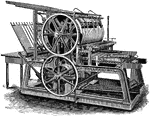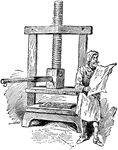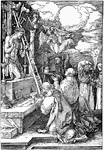
The Mass of St. Gregory
The Mass of St. Gregory is a woodcut that was created by German artist Albrecht Dürer in 1511.…

The Holy Family
The Holy Family is a woodcut that was creates by Albrecht Dürer in 1511. It depicts Mary and Jesus…
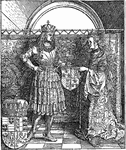
The Emperor Maximilian and his Bride, Mary of Burgundy
The Emperor Maximilian and his Bride, Mary of Burgundy is a woodcut that was created by German artist…
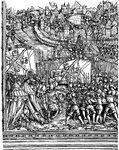
Troops Entering a Town After a Siege
Troops Entering a Town After a Siege is a woodcut that was created by German artist Albrecht Dürer.…
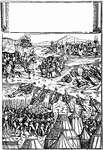
The Emperor Maximilian Receiving the Submission of a Besieged City
The Emperor Maximilian Receiving the Submission of a Besieged City is a woodcut that was created by…

The Investiture of the Duke of Milan
The Investiture of the Duke of Milan is a woodcut that was created by German artist Albrecht Dürer.…

The Virgin and Child Surrounded by Angels
The Virgin and Child Surrounded by Angels is a woodcut that was created by German artist Albrecht Dürer…
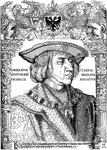
Emperor Maximilian
This a woodcut portrait of the Emperor Maximilian. It was created by Albrecht Dürer in 1519. A woodcut…
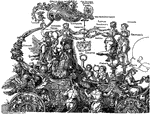
The Emperor Maximilian on the Triumphal Car
The Emperor Maximilian on the Triumphal Car is a woodcut that was created by German Artist Albrecht…

Albrecht Dürer's Pirkheinmer Border
Albrecht Dürer's Pirkheimer Border is a woodcut that was created by German artist Albrecht Dürer…
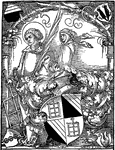
Bookplate of Hector Pomer
This bookplate of Hector Pomer is woodcut that was created by German artist Albrecht Dürer. Pomer…
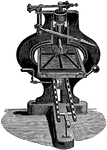
Stanhope Press
Charles Stanhope improved upon Gutenberg's press by making it out of cast iron therefore reducing the…

Columbian Press
George Clymer improved upon Gutenberg's press by making it out of iron therefore reducing the force…

Hand Press
The hand printing press was invented by Peter Smith and manufactured by Robert Hoe in 1822.

Treadwell's Platen Printing Press
"Treadwell's wooden-frame bed and platen power press, 1822." -Hill, 1921

Double Cylinder Press
"Double cylinder press, 1835-1900. These presses were built up to 1900 and this picture shows the latest…
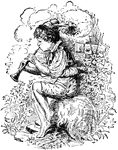
Line Engraving
"The making of line engravings follows the same general course, with the exception that no halftone…
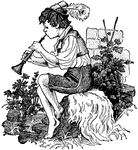
Benday Engraving
"The Benday process, so called, is the use of mechanical appliances for adding lines or stipples to…
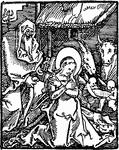
Hortulus Animae
The Hortulus Animae is one of a series of woodcuts that was created by German Renaissance artist Hans…
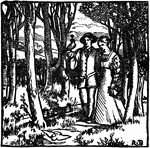
Art in the House
This print is part of a series of woodcuts called Art in the house that was designed by English artist…

Phillip's Pastoral
Phillip's pastoral is a woodcut that was created by English poet, painter and printmaker William Blake.…
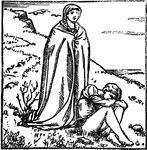
Art in the House
This print is part of a series of woodcuts called Art in the House by English artist Robert Bateman…
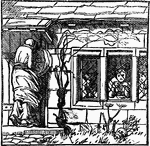
Art in the House
This is part of a series of woodcuts called Art in the House that was designed by English artist Robert…
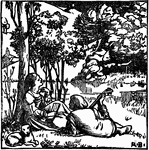
Art in the House
This is part of a series of woodcuts called Art in the House that was designed by English artist Robert…

The Inner Workings of Telegraphy
Telegraphy is the long distance transmission of written messages without physical transport of letters.…

Printing Press
A printing press is a mechanical device for applying pressure to a inked surface resting upon a medium,…

Printers Galley
In printing and publication, proofs are preliminary versions of publications. They may be uncut and…
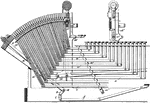
Linotype Machine
A Linotype machine is a line casting machine used in printing. The machine revolutionized printing and…

Early Model Linotype Machine
The Linotype machine is a line casting machine that is commonly used in printing. This machine modernized…
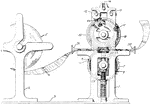
Ticket Printing Machine
The present invention relates to a printing machine for printing price tickets, in which is combined…

Printing Frame
Device used for contact printing that holds a negative against the photographic paper. The paper is…

Hydraulic Press
Press in which a force applied by a piston to a small area is transmitted through water to another piston…
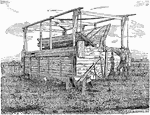
Homemade Jumbo Windmill
"Devices for lifting water are older than written history, and various forms of pumps are used on almost…

Centrifugal Pump
"Some forms of centrifugal pump, however, have been designed for use with horse power and even for windmills."—Government…
Section of Field and Lateral Ditch
"From the reservoir, whether constructed on a large scale to hold storm water or of small size to receive…

Section of Raised Ditch
"It is desirable, however, on account of economy of expense and of water, that all ditches should be…
Combined Wood and Iron Flume
"The section of the flume is usually rectangular, but it may be of a V shape, and occasionally, as in…
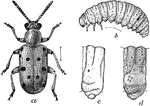
Crioceris 12-Punctata
"The mature beetle in life rivals asparagi in beauty, but may be distinguished by its much broader elytra…
!["By the time [olive trees] are well grown the form of the young tree is established, and further pruning for form may be done in a general manner to obtain the following results: (1) Maintenance of a comparatively open center to the tree; (2) exposure to the sun and air as large a number as possible of last year's branches around the circumference of the tree; (3) removal of all ground suckers and water sprouts; (4) preservation of outward-growing and drooping basal and lateral fruit branches; (5) heading back of upward-growing limbs, which consume much, but produce little; and, (6) the removal of all diseased or injured wood. In pruning for form the rules governing pruning for fruit should be kept in mind."—Government Printing Office, 1897](https://etc.usf.edu/clipart/78900/78990/78990_olivetree_mth.gif)
An Olive Tree
"By the time [olive trees] are well grown the form of the young tree is established, and further pruning…

Behavior of Fibers in Tension Test
"Since the strength of the fibers in adhesion is very much less than in tension and compression, adhesion…
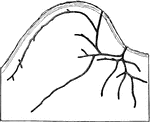
Gallery of Xyleborus Pubescens
"The females alone excavate the domiciles, which consist either of branching galleries, as in the gallery…

Single-Comb White Leghorn Cock
"Leghorns are the best known of the egg-producing varieties or Mediterranean class. They are the premiers…
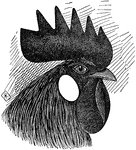
Head of Single-Comb Brown Leghorn Cock
"The comb is single, of medium size, perfectly straight and upright upon the head, free from side sprigs,…
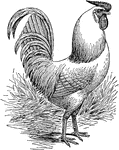
Rose-Combed White Leghorn Cockerel
"The Rose-comb White and Rose-comb Brown Leghorns have a small rose comb, square in front, firm and…
!["These [upright] systems are sometimes referred to as the "goblet" systems, since when the shoots are tied together the plant bears a certain resemblance to such a glass. As a rule, these vines make comparatively little growth, and the canes are severely cut back each year."—Government Printing Office, 1897](https://etc.usf.edu/clipart/79000/79013/79013_uprightgrape_mth.gif)
Upright System of Grape Training
"These [upright] systems are sometimes referred to as the "goblet" systems, since when the shoots are…
!["When a grapevine is first set in a vineyard, it closely resembles the plant shown in [the image]. Such a rooted cutting may be one or two years old, the former being preferable in the majority of cases. The cane is cut back to two buds, and during the first season its shoots are allowed to lie prone upon the surface of the soil."—Government Printing Office, 1897](https://etc.usf.edu/clipart/79000/79014/79014_rootedgrape_mth.gif)
Rooted Grape Cutting
"When a grapevine is first set in a vineyard, it closely resembles the plant shown in [the image]. Such…
!["The cross-wire system is another method of training which appears to be confined in this country to the Hudson River Valley, and even there it is used only to a limited extent. But at Juraçon, Bassess-Pyrénées, France, this system is regularly followed. Poles are used in place of the wires, however. [The image] represents vines trained in this manner."—Government Printing Office, 1897](https://etc.usf.edu/clipart/79000/79015/79015_crosswire_mth.gif)
Cross-Wire System of Grape Training
"The cross-wire system is another method of training which appears to be confined in this country to…

Feeder, Printing Press
This is a printing press attachment that is used to facilitate the process of feeding paper into a printing…

Letterpress Printing Uppercase Tray
Tray full of capital and small capital letters and symbols used in the letterpress printing process.…

Letterpress Printing Lowercase Tray
Tray containing the lowercase letters of the alphabet, used in the letterpress printing process. Known…

Sheep's Foot Tool
"In printing, an iron hammer with a split curved claw at the end which serves for a handle. The claw…

Slice Tool in the Printing Trade
"In printing, a small spade-shaped iron tool with which printing ink is taken out of a tub and conveyed…

